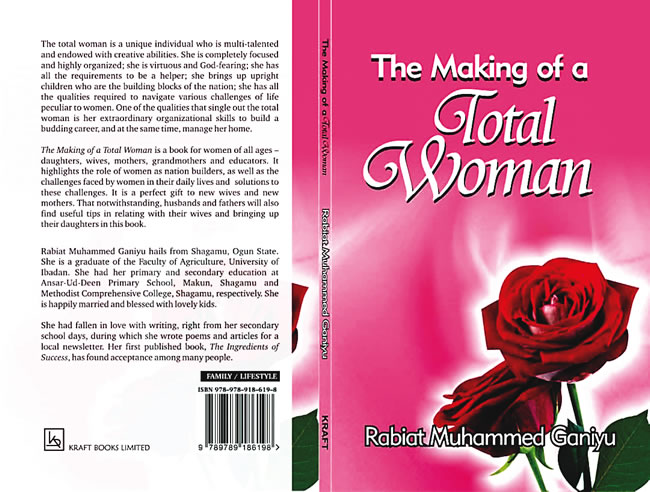A Review of Rabiat Muhammed Ganiyu’s ‘The Making of A Total Woman.’
THE book, The Making of A Total Woman, written by Rabiat Muhammed Ganiyu, a beneficiary of the Ebedi Writers Residency, Iseyin, is a publication of Kraft Books Limited, one of the few leading publishing outfits in Nigeria with a rich tradition of publishing poetry works.
The Making of A Total Woman is a 78-page book, which is divided into 17 chapters with most of the chapters dealing with different but interwoven themes of feminine importance. The book, written in third person singular, is an instructional material, a great guide towards making the female gender live a fulfilled life. If life is truly a journey, every child, especially the girl-child, has a long way to go. The journey from girlhood to womanhood is a journey of answers begging for questions, and a trip of solutions searching for problems because the road leading to a fulfilled life seems to be smooth, but it is very slippery. No star has a smooth ride to stardom.
The preface and the introduction by the author as well as the foreword by Wale Okediran succinctly open the mind of the reader to what the book is set out to offer and achieve. It is all about the trip from girlhood to motherhood and beyond. What is moving and compelling in Okediran’s foreword are actually the stages a girl-child will pass through in life before becoming a total woman. While the preface tells a well known scriptural tale of the first man and woman in the Garden of Eden and later on the planet earth in relation to marriage, the author uses the introduction to set a tone of comparison between the functionality of an ancient woman and that of a modern woman in and outside the home.
From there, the theme and sub-themes of the book explode across the page with instructional, persuasive and warning words which are skillfully combined by the author to form the directional guide for women on the road to a fulfilled life. Chapter one, ‘The Girl-Child’, which starts with the birth of the girl-child, deals extensively with issues around the boy-child preference as they affected his female counterpart in ancient times. But in modern times, the slogan is, ‘What a man can do, a woman can even do better’. The era of choosing a spouse for her when she is ripe for marriage is gone by.
In chapter two, ‘The Fiancée’, the girl-child has become a lady. The author uses this chapter to guide all ladies who are aspiring to enter into a marital life to be cautious. The guide includes dos and don’ts of the process of choosing a suitor perhaps from the pool of suitors. In all, the young lady should involve God as her guide in the selection process. In other words, the author is telling the reader that the safer sex for unmarried couples is no sex i.e. no pre-marital sex. The author instructs every aspiring wife to cut off any man who demands for sex before marriage.
From chapter three to chapter five, the author paints the expected scenarios that a woman will encounter from the wedding day till she becomes a bride and settles down as the Chief Executive Officer for home affairs if her husband is wealthy or the Managing Director of home affairs if her husband has meagre resources. What will strike the reader in chapter five is not only the position of the two major religions in Nigeria on polygamous but also the way the author enjoins every wife to adore and respect her husband. Here she sounds like Marabel Morgan, the author of a successful non-fiction book entitled, ‘Total Woman’, a self help book for married women published in 1973 in the USA. It sold over 500,000 copies within 365 days. By the end of 1974, it had sold over 10 million copies worldwide. On page 58 of the book, Marabel Morgan admonishes that a wife should respect, honour, adore, praise, enjoy and admire her husband. The only difference between Morgan’s perspective and that of Rabiat is in the manner of dressing. While both authors enjoin the wife to ‘dress to kill’ for her husband, Rabiat quickly adds, ‘she should wear only decent clothes when going out’. ‘Decent clothes’ is not in Morgan’s book. Even the dress to kill philosophy in Morgan’s book goes beyond what Rabiat charges every wife for. For example, Morgan advocates for a wife greeting her husband at the door naked or wearing some sexually provocative materials like a porn star. But the crucial message in these two great books is that both authors are trying to save many marriages from hitting the rocks.
As a realist, Rabiat strikes a controversial chord on the issue of polygamy when she enjoins every Muslim wife to admit the fact that her husband may marry other women and prepare for the eventuality because ‘A Muslim man is permitted to marry up to four wives’. But what did Quran say about polygamy? In suratul An-Nisaa (The women) verse 3, it reads,
‘And if you wish to marry them and you fear that you will not be able to do justice to the orphan girls then marry them not, rather marry of women other than these as may be agreeable to you. You may marry two or three or four provided you do justice to them, but if you fear that you will not be able to deal with all of them equally, then confine yourself only to one…’.
This is not to say the author is not aware of this but the reality on the ground is that the punishment for marrying more than one wife and not treating them equally may not come now until hereafter. The sin of unequal treatments committed may be forgiven after all.
The natural test of motherhood is treated in chapter six, ‘During Pregnancy’. The routine activities at the antenatal clinic and the how-to of pregnancy are explained in this chapter. The author takes the reader on a trip that starts from the pregnancy stage to the delivery stage, when she becomes a mother! When a baby is born, a new mother is also born. A baby is born once, but a mother can be born multiple times. Chapter seven explains the expected changes in a new mother, especially a first-time mother, in relation to her roles and environment. The preparation for naming ceremony and what to expect during and after the ceremony are explained also in this chapter.
The travails, challenges and joy of motherhood are extensively covered from chapter 8, ‘The New Mother’ to chapter 12, ‘The Working Mother’. The new mother breastfeeds her child, loses sleep in the process of caring for her child, suffers from soreness, experiences baby blues that has to do with negative feelings or mood swings, may have postpartum depression, struggles to get back in shape and may be under intense pressure of returning to work. Every mother needs to have an eagle eye or a third eye to be able to protect her daughter from peadophiles, who are sexually attracted to children. Here the mother plays with pain to patronize pleasure. She lashes at hatred to listen to love and dines with death to truly live and secure a life. The author’s ‘how-to’ of getting back to shape and that of easing the pressure of returning to work are comprehensive and educative. The challenges of a working mother that chapter 12 deals with reinforce the belief that a new mother is on a national service and deserves a national allowance for replenishing and nourishing the earth. The hallmark of chapter 12 are the tips that the author propounds for working mothers to be able to balance work and family. Owing to her multi-tasking roles at home and in workplace, the author calls the working mother a heroine. Since the word, ‘heroine’ has ‘He’, maybe we should call her ‘Shero’.
The metaphor of an empty nest when the children have developed the wings given to them by their mother and father and flown away into their own respective nests thereby leaving the parental nest alone for their mother and father will interest the reader in chapter 13. The how-to of coping with the empty nest syndrome for every parent is eye-opening and enlightening.
The golden years are nothing but old age when the woman or mother will become a senior citizen with grey hair and wisdom. It is a time for the mother to sit back and enjoy the fruits of her labour. But she needs to stay healthy. Chapter 14 deals with what she needs to be doing and eating to stay happy and healthy for longevity.
The last three chapters directly link the power and the roles of women to community and national development. If a woman can create new but good values in her husband, if a woman can create new but good values in her children, if a woman can create civic values in her community, logically she can create new but good values in a nation. In raising her son, the author reminds her that she is raising somebody’s husband and someone’s father. Also in raising her daughter, Rabiat reminds her that she is raising somebody’s wife and someone’s mother. Rabiat, however, screams at every mother, ‘Raise your children well!’
In raising the children well, the home, the school and the society all have complementary roles to play. If these roles are played effectively and efficiently they will bestow certain essential qualities on a woman that will make her a total woman who, in the not-too-distant future, will become a tool for community and national development.
The strength of this book lies in the fact that it is a product of qualitative research based on observations and experiences. Every moral issue that the book powerfully and gratefully pushes to the reader can be seen, proved and touched. This will make every woman to see herself in the book. It will make the girl-child to cautiously climb the hill of childhood and view the outcrop of delightful womanhood that tells a tale of joyful pain, and a tale of painful joy. The Making of A Total Woman comprehensively presents a load of knowledge that screams at ignorance. However its weak point, which is very difficult to notice, is the repetition of ideas necessitated by the author’s urge to lay emphasis and to complete the trip of the Making Of A Total Woman.
How are you preparing your girl-child and boy-child for the present and future battles of life? How are you teaching them moral values at home, in school and within the society? How can we build a nation that we all want and be proud of using women as pivots? Rabiat Muhammed Ganiyu’s ‘The Making of A Total Woman’, written in lucid language, a must read for every woman, man, parent and teacher provides answers to these questions. Let us create our own Marabel Morgan in Rabiat Muhammed Ganiyu by buying copies of this book for your libraries, schools, friends, professional colleagues and loved ones.
WATCH TOP VIDEOS FROM NIGERIAN TRIBUNE TV
- Relationship Hangout: Public vs Private Proposals – Which Truly Wins in Love?
- “No” Is a Complete Sentence: Why You Should Stop Feeling Guilty
- Relationship Hangout: Friendship Talk 2025 – How to Be a Good Friend & Big Questions on Friendship
- Police Overpower Armed Robbers in Ibadan After Fierce Struggle






